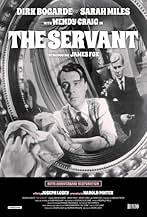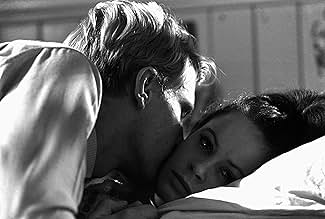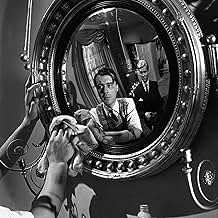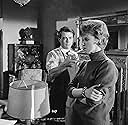The Servant
- 1963
- Tous publics
- 1h 56min
NOTE IMDb
7,8/10
15 k
MA NOTE
Issu de la haute société, Tony embauche Hugo Barrett, qui s'avère avoir des intentions cachées.Issu de la haute société, Tony embauche Hugo Barrett, qui s'avère avoir des intentions cachées.Issu de la haute société, Tony embauche Hugo Barrett, qui s'avère avoir des intentions cachées.
- Réalisation
- Scénario
- Casting principal
- Victoire aux 3 BAFTA Awards
- 8 victoires et 11 nominations au total
Doris Nolan
- People in restaurant: Older Woman
- (as Doris Knox)
Avis à la une
The Servant is directed by Joseph Losey and adapted to screenplay by Harold Pinter from the novelette of the same name written by Robin Maugham. It stars Dirk Bogarde, Sarah Mles, Wendy Craig and James Fox. Music is by John Dankworth and cinematography by Douglas Slocombe.
When well-to-do Londoner Tony (Fox) hires Hugo Barrett (Bogarde) as his manservant, he gets more than he bargained for. Especially when Hugo's sister Vera (Miles) also arrives on the scene
The Servant remains as enigmatic today as it was back on its release in the early part of the 1960s. It's a film that defies classification, that rare old cinematic treat that continues to cause debate about not only its worth as art, but also its very meaning(s). A head bothering delight that revels in toying with your perceptions as much as Hugo Barrett enjoys toying with his supposed master. Lets play master and servant - indeed.
Set predominantly in the confines of Tony's swanky Chelsea abode, there's a disturbing claustrophobia that pervades the narrative, and this before we even begin to ponder the power of man, his ability to dominate and manipulate, or the reverse side that sees another's lack of ability to not succumb to the downward spiral instigated by a supposed lesser man.
Sprinkled over power issues are sexual desires, obtained, unfulfilled or simmering away unspoken. As the literate screenplay comes out in sharp dialogue snatches, breaking free of Pinter's other wise cement ensconced writing, there's evidence that this is a psychological study as opposed to the class system allegory that many thought it was way back then. This really isn't about role reversal, the finale tells us that.
Visually it's a box of atmospheric tricks as well. Losey and Slocombe use deep angular black and white photography to enforce the chilly dynamics at work in the story, the longer the film goes on, as it gets to the nitty gritty, the more jarring the camera work becomes – delightfully so – the house no longer an affluent person's residence, but a skew-whiff place of debauchery and mind transference. And mirrors - reflections, important and used to great effect.
Some scenes are striking and rich. Hugo at the top of the stairs standing in the bedroom doorway, in silhouette, an overhead shot of Hugo and Tony playing a childlike ball game on the stairs, a sex scene on a leather chair that we don't see but understand totally. And many more as Losey finds the material that allows him to show his skills.
Cast performances are across the board terrific, particularly Bogarde who gives a visual acting master class, and Fox who beautifully shifts a gear from toff twit into dependant dead beat. While Dankworth's musical accompaniments add flavour to the unfolding machinations. 9/10
When well-to-do Londoner Tony (Fox) hires Hugo Barrett (Bogarde) as his manservant, he gets more than he bargained for. Especially when Hugo's sister Vera (Miles) also arrives on the scene
The Servant remains as enigmatic today as it was back on its release in the early part of the 1960s. It's a film that defies classification, that rare old cinematic treat that continues to cause debate about not only its worth as art, but also its very meaning(s). A head bothering delight that revels in toying with your perceptions as much as Hugo Barrett enjoys toying with his supposed master. Lets play master and servant - indeed.
Set predominantly in the confines of Tony's swanky Chelsea abode, there's a disturbing claustrophobia that pervades the narrative, and this before we even begin to ponder the power of man, his ability to dominate and manipulate, or the reverse side that sees another's lack of ability to not succumb to the downward spiral instigated by a supposed lesser man.
Sprinkled over power issues are sexual desires, obtained, unfulfilled or simmering away unspoken. As the literate screenplay comes out in sharp dialogue snatches, breaking free of Pinter's other wise cement ensconced writing, there's evidence that this is a psychological study as opposed to the class system allegory that many thought it was way back then. This really isn't about role reversal, the finale tells us that.
Visually it's a box of atmospheric tricks as well. Losey and Slocombe use deep angular black and white photography to enforce the chilly dynamics at work in the story, the longer the film goes on, as it gets to the nitty gritty, the more jarring the camera work becomes – delightfully so – the house no longer an affluent person's residence, but a skew-whiff place of debauchery and mind transference. And mirrors - reflections, important and used to great effect.
Some scenes are striking and rich. Hugo at the top of the stairs standing in the bedroom doorway, in silhouette, an overhead shot of Hugo and Tony playing a childlike ball game on the stairs, a sex scene on a leather chair that we don't see but understand totally. And many more as Losey finds the material that allows him to show his skills.
Cast performances are across the board terrific, particularly Bogarde who gives a visual acting master class, and Fox who beautifully shifts a gear from toff twit into dependant dead beat. While Dankworth's musical accompaniments add flavour to the unfolding machinations. 9/10
About midpoint Tony's girlfriend Susan asks servant Hugo, "What do you want from this house?" It's a direct and pointed question that's ambiguously answered ("I'm just the servant, mum.")
That ambiguity carries the dramatic tension along its murky but intriguing path, as a strange play of power and manipulation unfolds. Yet after a series of quirkly developments transpire and the tables of manservant and master are reversed, what's the real gain?
What was there in the house in the first place that was worth all the fuss and bother to acquire? Satisfaction of taking over the master role?
Whatever the goal, it all seems a tawdry victory. After the shoe's on the other foot and a few points are scored in this cheesy power game, where's the spoil?
What does drive this drama is Pinter's genius for inventing small talk that gives the illusion of grandeur Losey's direction is right on the mark, and the production design, score, photography--and the acting--are all top drawer.
As in his subversive play, "The Homecoming," Pinter manages to hold the attention with his unique pregnant pauses and hypnotic ambiance, which are actually illusionary. It could be a play about something very important or about nothing.
One thing is for certain: once "The Servant" is seen, one never quite forgets it.
This remains Dirk Bogarde's defining cinematic role.
That ambiguity carries the dramatic tension along its murky but intriguing path, as a strange play of power and manipulation unfolds. Yet after a series of quirkly developments transpire and the tables of manservant and master are reversed, what's the real gain?
What was there in the house in the first place that was worth all the fuss and bother to acquire? Satisfaction of taking over the master role?
Whatever the goal, it all seems a tawdry victory. After the shoe's on the other foot and a few points are scored in this cheesy power game, where's the spoil?
What does drive this drama is Pinter's genius for inventing small talk that gives the illusion of grandeur Losey's direction is right on the mark, and the production design, score, photography--and the acting--are all top drawer.
As in his subversive play, "The Homecoming," Pinter manages to hold the attention with his unique pregnant pauses and hypnotic ambiance, which are actually illusionary. It could be a play about something very important or about nothing.
One thing is for certain: once "The Servant" is seen, one never quite forgets it.
This remains Dirk Bogarde's defining cinematic role.
This is a superb, sinister movie of the very highest class. Unlike the character Tony (James Fox) who is upper class without being high class, if you get my drift. You cannot really sympathise with Tony, who toys with some high falutin' development projects but basically is a wastrel just waiting to be ponced off. Tony is a later-day Bertie Wooster. The sinister element comes from the servant (Dirk Bogarde), who is no Jeeves. Barrett, like Jeeves , is a gentleman's gentleman or valet (not a butler as suggested in some other comments on this film). Tony needs a valet because he is incapable of doing anything much without help. Barrett and his accomplice Vera (Sarah Miles) take Tony to the cleaners, sweeping aside the fiancee Susan (Wendy Craig) in their wake.
Harold Pinter has written the screenplay in similar vein to the superb movie The Accident, also a Losey piece, which I also commend. The cinematography in both movies is simply excellent. The subject matter of The Servant suits Pinter, although much of the screenplay is not really in Pinter's voice. However, there is one scene, set in a restaurant, which includes a tiny cameo by Pinter himself and which contains a short Pinteresque exchange between two women. There is also one tense exchange between Susan and Barrett "do you wear deodorant" etc. which is very reminiscent of a scene in The Caretaker "you stink from arsehole to Thursday" etc. Indeed the story of The Servant resembles The Caretaker in many respects, except that in The Servant the interloper, Barrett, is on top and stays there, whereas in The Caretaker the interloper, Davies, lacks the skill and circumstances to dislodge the incumbent.
There is a homoerotic undercurrent to the film and this works so well because it is an undercurrent (in 1963 there could have been no more than an undercurrent even if they had wanted more). The overt debauchery with Vera and the orgy party towards the end of the film is the only bit of the film that has aged without grace. But I quibble.
This is a truly great film and it deserves to be more widely known.
Harold Pinter has written the screenplay in similar vein to the superb movie The Accident, also a Losey piece, which I also commend. The cinematography in both movies is simply excellent. The subject matter of The Servant suits Pinter, although much of the screenplay is not really in Pinter's voice. However, there is one scene, set in a restaurant, which includes a tiny cameo by Pinter himself and which contains a short Pinteresque exchange between two women. There is also one tense exchange between Susan and Barrett "do you wear deodorant" etc. which is very reminiscent of a scene in The Caretaker "you stink from arsehole to Thursday" etc. Indeed the story of The Servant resembles The Caretaker in many respects, except that in The Servant the interloper, Barrett, is on top and stays there, whereas in The Caretaker the interloper, Davies, lacks the skill and circumstances to dislodge the incumbent.
There is a homoerotic undercurrent to the film and this works so well because it is an undercurrent (in 1963 there could have been no more than an undercurrent even if they had wanted more). The overt debauchery with Vera and the orgy party towards the end of the film is the only bit of the film that has aged without grace. But I quibble.
This is a truly great film and it deserves to be more widely known.
I first watched Losey's most famous work - but not quite his best, in my opinion - on the big-screen at London's National Film Theatre in 1999, just a few months after star Dirk Bogarde's death; it's certainly one of the latter's most significant roles (along with the homosexual composer of DEATH IN VENICE [1971], perhaps his most representative), though I still feel that VICTIM (1961) is the finest film he's ever been associated with!
Even so, Bogarde's performance (recipient of the BAFTA award) is understated most of the time - which rather suits his enigmatic title character, a self-described "gentleman's gentleman" but actually harboring sinister ambitions. Interestingly, when Joseph Losey fell ill in mid-production, the directorial chores were thrust into the hands of the leading man until his recovery - who, amusingly, initially turned Losey down by saying that he "couldn't direct a bus" if his life depended on it!
While he was still some years away from the deliberate formalism that virtually characterized all his later output, Losey's style is here more controlled - for lack of a better word - than in, say, THE CRIMINAL (1960) or EVA (1962); this may have been due to the 'failure' of the latter (see my review elsewhere), or perhaps his collaboration with screenwriter (and influential playwright) Harold Pinter may have had more to do with this than anything else. Still, Douglas Slocombe's sleek black-and-white cinematography (also a BAFTA award winner) of the gloomy London settings - abetted by Johnny Dankworth's wistful score - is certainly among the film's most notable assets.
James Fox's fine performance as the usurped master of the house led him to short-lived stardom (and even copped the young actor the "Most Promising Newcomer" award at the BAFTAs); his career went on an extended hiatus some years later (which ended in the mid-Eighties) following his traumatic experience on the set of PERFORMANCE (1970), curiously enough a film dealing with a similar role-reversal situation! Though the women are subservient to the central relationship between Bogarde and Fox, both Sarah Miles and Wendy Craig serve their characters well; especially interesting is the battle of wits between the latter (as Fox's upper-class girlfriend) and Bogarde, whom she mistrusts from the get-go and is obviously proved right beyond her wildest imagination!
For a two-hour dialogue-driven film, the plot is pretty sparse - typically of Pinter, dealing in symbolism rather than presenting a straightforward narrative (despite being based on a novel by Robin Maugham) - but the tension between the various characters holds the viewer's attention all the way...though the final descent into depravity and degradation comes off as rather too abrupt and now seems more farcical than shocking (as it must have seemed at the time)! The cast also includes bit parts by two alumni of Losey's THE CRIMINAL - co-star Patrick Magee and screenwriter Alun Owen, sparring amusingly as a couple of clergymen in a bar! - as well as Pinter himself (a former actor in his own right, appearing as a 'society man' in the same scene, actually one of the very few set outside Fox's mansion).
There's a hilarious scene in which James Fox goes with Wendy Craig to visit her "mummified" high society parents. This enables Bogarde and Miles to live it up at the house during their absence. However, they cut short their visit and catch them romping about in their master's bedroom, whereupon he sacks them on the spot. This leads to the film's best scene, in my opinion: the chance meeting in a bar between Bogarde and Fox (who has, in the interim, fallen on hard times) where the Mephistophelean Bogarde paints a pitiful picture of himself which, inevitably, leads the lonesome Fox to engage his services once more. The way Losey shoots this marvelous sequence is masterly - with a minimum of camera movement and the actors strategically placed within the frame.
Trivia note: I own a British periodical from the early 80s called "The Movie" - a collection of essays strung together more or less by theme and running for an impressive 158 volumes - in which THE SERVANT was among the films chosen for a two-page critical evaluation, accompanied by a detailed synopsis and illustrated by numerous stills; I've leafed through it and read the review (written by Derek Prouse) so many times that these images from the film have become fixed in my mind and, as I lay watching, I was actively looking out for each one of them!
Even so, Bogarde's performance (recipient of the BAFTA award) is understated most of the time - which rather suits his enigmatic title character, a self-described "gentleman's gentleman" but actually harboring sinister ambitions. Interestingly, when Joseph Losey fell ill in mid-production, the directorial chores were thrust into the hands of the leading man until his recovery - who, amusingly, initially turned Losey down by saying that he "couldn't direct a bus" if his life depended on it!
While he was still some years away from the deliberate formalism that virtually characterized all his later output, Losey's style is here more controlled - for lack of a better word - than in, say, THE CRIMINAL (1960) or EVA (1962); this may have been due to the 'failure' of the latter (see my review elsewhere), or perhaps his collaboration with screenwriter (and influential playwright) Harold Pinter may have had more to do with this than anything else. Still, Douglas Slocombe's sleek black-and-white cinematography (also a BAFTA award winner) of the gloomy London settings - abetted by Johnny Dankworth's wistful score - is certainly among the film's most notable assets.
James Fox's fine performance as the usurped master of the house led him to short-lived stardom (and even copped the young actor the "Most Promising Newcomer" award at the BAFTAs); his career went on an extended hiatus some years later (which ended in the mid-Eighties) following his traumatic experience on the set of PERFORMANCE (1970), curiously enough a film dealing with a similar role-reversal situation! Though the women are subservient to the central relationship between Bogarde and Fox, both Sarah Miles and Wendy Craig serve their characters well; especially interesting is the battle of wits between the latter (as Fox's upper-class girlfriend) and Bogarde, whom she mistrusts from the get-go and is obviously proved right beyond her wildest imagination!
For a two-hour dialogue-driven film, the plot is pretty sparse - typically of Pinter, dealing in symbolism rather than presenting a straightforward narrative (despite being based on a novel by Robin Maugham) - but the tension between the various characters holds the viewer's attention all the way...though the final descent into depravity and degradation comes off as rather too abrupt and now seems more farcical than shocking (as it must have seemed at the time)! The cast also includes bit parts by two alumni of Losey's THE CRIMINAL - co-star Patrick Magee and screenwriter Alun Owen, sparring amusingly as a couple of clergymen in a bar! - as well as Pinter himself (a former actor in his own right, appearing as a 'society man' in the same scene, actually one of the very few set outside Fox's mansion).
There's a hilarious scene in which James Fox goes with Wendy Craig to visit her "mummified" high society parents. This enables Bogarde and Miles to live it up at the house during their absence. However, they cut short their visit and catch them romping about in their master's bedroom, whereupon he sacks them on the spot. This leads to the film's best scene, in my opinion: the chance meeting in a bar between Bogarde and Fox (who has, in the interim, fallen on hard times) where the Mephistophelean Bogarde paints a pitiful picture of himself which, inevitably, leads the lonesome Fox to engage his services once more. The way Losey shoots this marvelous sequence is masterly - with a minimum of camera movement and the actors strategically placed within the frame.
Trivia note: I own a British periodical from the early 80s called "The Movie" - a collection of essays strung together more or less by theme and running for an impressive 158 volumes - in which THE SERVANT was among the films chosen for a two-page critical evaluation, accompanied by a detailed synopsis and illustrated by numerous stills; I've leafed through it and read the review (written by Derek Prouse) so many times that these images from the film have become fixed in my mind and, as I lay watching, I was actively looking out for each one of them!
If you watch closely you will find that not only does the internal decoration of the house change (in ways not included in the plot) to become gradually darker as Tony is gradually undermined and seduced by Barrett but also the excellent (but very much of its time) soundtrack by Johnny Dankworth & (surely - or is my recollection wrong?) Cleo Laine - though the same LP is put on the turntable many times, the arrangement of the same theme is different. (I did not notice this at first but found it pointed out in a special issue of the Oxford University magazine Isis at the time the film was released that was entirely devoted to it.) The film has recently reappeared in England as a stage work: Play without Words, seen at the National Theatre, is (was, I guess, is more accurate) a superb piece of dance theatre in which the ambiguities of the characters' motivations, or the discrepancies between their thoughts and actions, are portrayed by having more than one dancer per character. Sometimes only one is seen, sometimes they move in unison, sometimes in separate ways. It is extremely effective.
Le saviez-vous
- AnecdotesWhen producer and director Joseph Losey was hospitalized with a brutal case of pneumonia for two weeks during this shoot, Dirk Bogarde continued filming assisted by minute, daily instructions over the phone from Losey's hospital bed. When Losey returned to the set, he did not re-shoot any of the script, much to the relief of cast and crew. Bogarde managed to keep the film on schedule, though he later said the experience made him determined never to direct.
- GaffesWhen Tony and Susan arrive at Tony's house in the Mercedes, with an extended visit in mind, they both go into the house and Tony leaves the car's lights on.
- Citations
Hugo Barrett: I'll tell you what I am. I'm a gentleman's gentleman, and you're no bloody GENTLEMAN!
- ConnexionsFeatured in Stairs (1986)
Meilleurs choix
Connectez-vous pour évaluer et suivre la liste de favoris afin de recevoir des recommandations personnalisées
- How long is The Servant?Alimenté par Alexa
Détails
Box-office
- Montant brut aux États-Unis et au Canada
- 45 522 $US
- Week-end de sortie aux États-Unis et au Canada
- 7 859 $US
- 28 juil. 2013
- Montant brut mondial
- 75 720 $US
- Durée1 heure 56 minutes
- Couleur
- Rapport de forme
- 1.66 : 1
Contribuer à cette page
Suggérer une modification ou ajouter du contenu manquant

Lacune principale
By what name was The Servant (1963) officially released in India in English?
Répondre
































